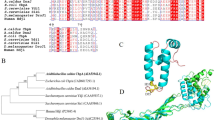Abstract
Acid tolerance is one of the critical factors to determine the quality of the industrial production strains. Therefore, we have investigated the introduction of the acid tolerance genes into the genome of Escherichia coli BL21 by using CRISPR-Cas9 system. The dsrA and rcsB genes of E. coli K-12, which are involved in the heptanoic acid tolerance, were inserted into the genome of E. coli BL21 without scar. The native transcription unit (TU) of dsrA and the synthetic TU of rcsB were integrated in E. coli BL21 genome. We found that the position of genomic coordinate of 1,300,270 was more efficient to integrate dsrA and rcsB than genomic coordinate of 3,876,428. Furthermore, the rcsB was successfully expressed in the resulting engineered strains (i.e., rcsB+ or dsrA+rcsB+ strains). The engineered strains expressing dsrA and/or rcsB showed the higher survival rate and specific growth rate under n-heptanoic acid stress than wild-type E. coli BL21. These results indicate that the newly introduced acid-tolerance systems were active in the E. coli BL21 strain.
Similar content being viewed by others
References
Desbois, A. P. and V. J. Smith (2010) Antibacterial free fatty acids: activities, mechanisms of action and biotechnological potential. Appl. Microbiol. Biotechnol. 85: 1629–1642.
Jarboe, L. R., L. A. Royce, and P. Liu (2013) Understanding biocatalyst inhibition by carboxylic acids. Front. Microbiol. 4: 272.
Lee, S. Y. and H. U. Kim (2015) Systems strategies for developing industrial microbial strains. Nat. Biotechnol. 33: 1061–1072.
Lease, R. A., D. Smith, K. McDonough, and M. Belfort (2004) The small noncoding DsrA RNA is an acid resistance regulator in Escherichia coli. J. Bacteriol. 186: 6179–6185.
Johnson, M. D., N. A. Burton, B. Gutierrez, K. Painter, and P. A. Lund (2011) RcsB is required for inducible acid resistance in Escherichia coli and acts at gadE-dependent and -independent promoters. J. Bacteriol. 193: 3653–3656.
Woo, J. -M., J. -W. Kim, J. -W. Song, L. M. Blank, and J. -B. Park (2016) Activation of the glutamic acid-dependent acid resistance system in Escherichia coli BL21(DE3) leads to increase of the fatty acid biotransformation activity. PLoS One 11: e0163265.
Castanie-Cornet, M. P., K. Cam, B. Bastiat, A. Cros, P. Bordes, and C. Gutierrez (2010) Acid stress response in Escherichia coli: Mechanism of regulation of gadA transcription by RcsB and GadE. Nucleic Acids Res. 38: 3546–3554.
Gaida, S. M., M. A. Al-Hinai, D. C. Indurthi, S. A. Nicolaou, and E. T. Papoutsakis (2013) Synthetic tolerance: three noncoding small RNAs, DsrA, ArcZ and RprA, acting supra-additively against acid stress. Nucleic Acids Res. 41: 8726–8737.
Cho, S. W., S. Kim, Y. Kim, J. Kweon, H. S. Kim, S. Bae, and J. S. Kim (2014) Analysis of off-target effects of CRISPR/Casderived RNA-guided endonucleases and nickases. Genome Res. 24: 132–141.
Riesenberg, D. (1991) High-cell-density cultivation of Escherichia coli. Curr. Opin. Biotechnol. 2: 380–384.
Jiang, Y., B. Chen, C. Duan, B. Sun, J. Yang, and S. Yang (2015) Multigene editing in the Escherichia coli genome via the CRISPR-Cas9 system. Appl. Environ. Microbiol. 81: 2506–2514.
Li, Y., Z. Lin, C. Huang, Y. Zhang, Z. Wang, Y. J. Tang, T. Chen, and X. Zhao (2015) Metabolic engineering of Escherichia coli using CRISPR-Cas9 meditated genome editing. Metab. Eng. 31: 13–21.
Bassalo, M. C., A. D. Garst, A. L. Halweg-Edwards, W. C. Grau, D. W. Domaille, V. K. Mutalik, A. P. Arkin, and R. T. Gill (2016) Rapid and efficient one-step metabolic pathway integration in E. coli. ACS Synth. Biol. 5: 561–568.
Trussart, M., E. Yus, S. Martinez, D. Bau, Y. O. Tahara, T. Pengo, M. Widjaja, S. Kretschmer, J. Swoger, S. Djordjevic, L. Turnbull, C. Whitchurch, M. Miyata, M. A. Marti-Renom, M. Lluch-Senar, and L. Serrano (2017) Defined chromosome structure in the genome-reduced bacterium Mycoplasma pneumoniae. Nat. Commun. 8: 14665.
Li, R., Y. Liu, T. Li, and C. Li (2016) 3Disease Browser: A web server for integrating 3D genome and disease-associated chromosome rearrangement data. Sci. Rep. 6: 34651.
Vora, T., A. K. Hottes, and S. Tavazoie (2009) Protein occupancy landscape of a bacterial genome. Mol. Cell 35: 247–253.
Bryant, J. A., L. E. Sellars, S. J. Busby, and D. J. Lee (2014) Chromosome position effects on gene expression in Escherichia coli K-12. Nucleic Acids Res. 42: 11383–11392.
Benard, L. (2004) Inhibition of 5' to 3' mRNA degradation under stress conditions in Saccharomyces cerevisiae: from GCN4 to MET16. RNA 10: 458–468.
Jang, H. -Y., K. Singha, H. -H. Kim, Y. -U. Kwon, and J. -B. Park (2016) Chemo-enzymatic synthesis of 11-hydroxyundecanoic acid and 1,11-undecanedioic acid from ricinoleic acid. Green Chem. 18: 1089–1095.
Jeon, E. -Y., J. -H. Seo, W. -R. Kang, M. -J. Kim, J. -H. Lee, D. -K. Oh, and J. -B. Park (2016) Simultaneous enzyme/whole-cell biotransformation of plant oils into C9 carboxylic acids. ACS Catal. 6: 7547–7553.
Koppireddi, S., J. -H. Seo, E. -Y. Jeon, P. S. Chowdhury, H. -Y. Jang, J. -B. Park, and Y. -U. Kwon (2016) Combined biocatalytic and chemical transformations of oleic acid to ω-hydroxynonanoic acid and α,ω-nonanedioic acid. Adv. Synth. Catal. 358: 3084–3092.
Seo, J. H., H. -H. Kim, E. -Y. Jeon, Y. -H. Song, C. -S. Shin, and J. -B. Park (2016) Engineering of Baeyer-Villiger monooxygenase-based Escherichia coli biocatalyst for large scale biotransformation of ricinoleic acid into (Z)-11-(heptanoyloxy)undec-9-enoic acid. Sci. Rep. 6: 28223.
Lee, N. -R., J. -Y. Yun, S. -M. Lee, and J. -B. Park (2015) Cyclohexanone-induced stress metabolism of Escherichia coli and Corynebacterium glutamicum. Biotechnol. Bioproc. Eng. 20: 1088–1098.
Author information
Authors and Affiliations
Corresponding author
Rights and permissions
About this article
Cite this article
Seo, JH., Baek, SW., Lee, J. et al. Engineering Escherichia coli BL21 genome to improve the heptanoic acid tolerance by using CRISPR-Cas9 system. Biotechnol Bioproc E 22, 231–238 (2017). https://doi.org/10.1007/s12257-017-0158-4
Received:
Revised:
Accepted:
Published:
Issue Date:
DOI: https://doi.org/10.1007/s12257-017-0158-4




